Effective attractants are low-molecular-weight, water-soluble compounds
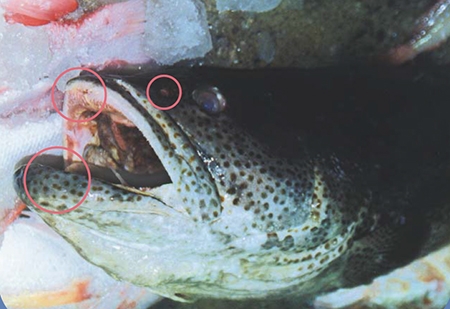
To reduce feed costs and avoid depletion of finite marine resources, aquaculture nutritionists are attempting to replace marine animal meals with plant proteins and rendered byproducts of terrestrial animals. Although considerable research has been devoted to the fortification of these alternative diets to compensate for nutritional deficiencies, little aquaculture research has focused on the importance of dietary attractants.
Detection systems
Specific, naturally occurring chemicals in the aquatic environment can represent cues for larval settlement, feeding, social interaction including both nonsexual and reproductive communication, and the detection of danger by other organisms. The primary sensory systems responsible for detecting chemicals in both land animals and the more complex aquatic invertebrates and vertebrates (crustaceans and fish) are olfaction, or smell, and gustation, or taste.
In most cases, both olfactory and taste systems are involved in sensing chemicals associated with feeding, whereas smell alone is used to detect chemicals associated with social interactions, including fright responses. The chemicals that make up this latter category are generally termed pheromones. Thus, the functions of the two chemical sensory systems can be very different, often affecting different chemosensory behaviors of the animal.
Differences between taste and smell
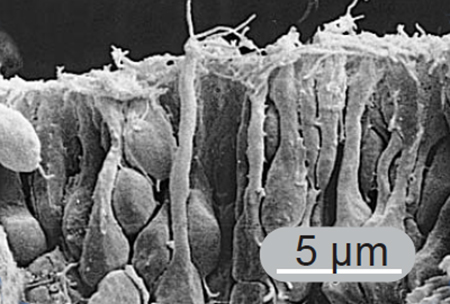
an adult zebrafish. Some of the receptor cells have long dendrites, while round receptor cells have short dendrites
The distinction between the two chemosensory systems in fish is as clear as it is for land vertebrates, including humans. Fish are bilaterally symmetric, and possess an olfactory organ (nose) in the anterior portion of each side of the head. Water enters the nose and circulates over the nerve cells, where specialized receptors (Fig. 1) detect specific chemicals dissolved in the water and transmit signals to the forebrain.
For taste, water circulates over the taste buds on the lips and within the oral cavity of fish. In addition, fish like catfish have taste buds that cover their entire external body surface. Due to this extreme specialization of the taste system, catfish have been termed “swimming tongues.” This broad distribution of taste buds appears to function as a large antenna, enabling the fish to simultaneously contrast the concentration of the chemicals contacting its body surface, thus giving directional cues to the chemical.
There are approximately 100 taste cells (Fig. 2) within one taste bud in fish. The process of detecting a taste involves the binding of chemicals in the water to their specific receptors in the taste cells. Binding triggers a series of cellular events that activate the nerve cells that transmit taste information to the hindbrain.
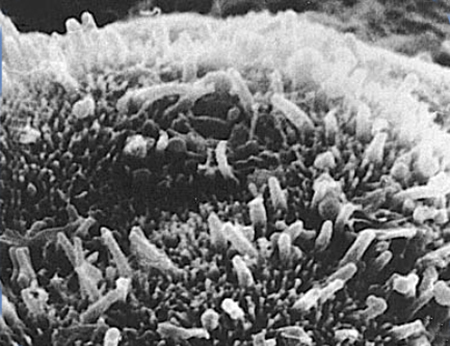
For crustaceans, the chemoreceptor cells are found primarily on the antennules, mouth, and legs. The antennule chemoreceptor neurons (Fig. 3) transmit chemical information directly to the forebrain and comprise part of the olfactory system, whereas the chemosensory neurons on mouth parts and legs transmit chemical information to the ventral nerve cord and are considered part of the taste system. Olfactory information from the antennules mediate orientation to odors, olfactory learning and olfactory discrimination, while the mouth and leg taste receptors mediate consumption, the picking up of food and ingestion.
Environmental stimuli
For land animals (tetrapods), the olfactory system detects volatile compounds, which transport over long distances in the air. Thus, the system is generally referred to as a “distance” sense (i.e., we can smell odors emanating from our neighbor’s barbecue grill quite well). Of course, there is no telemetry of odors. The actual chemicals must still be carried in the air to our nose and bind to the olfactory receptors prior to our being able to smell.
The chemicals that activate the taste system are generally water-soluble and must directly contact the taste buds. Taste in land animals is therefore considered a “contact” sense, and is generally less sensitive than smell.
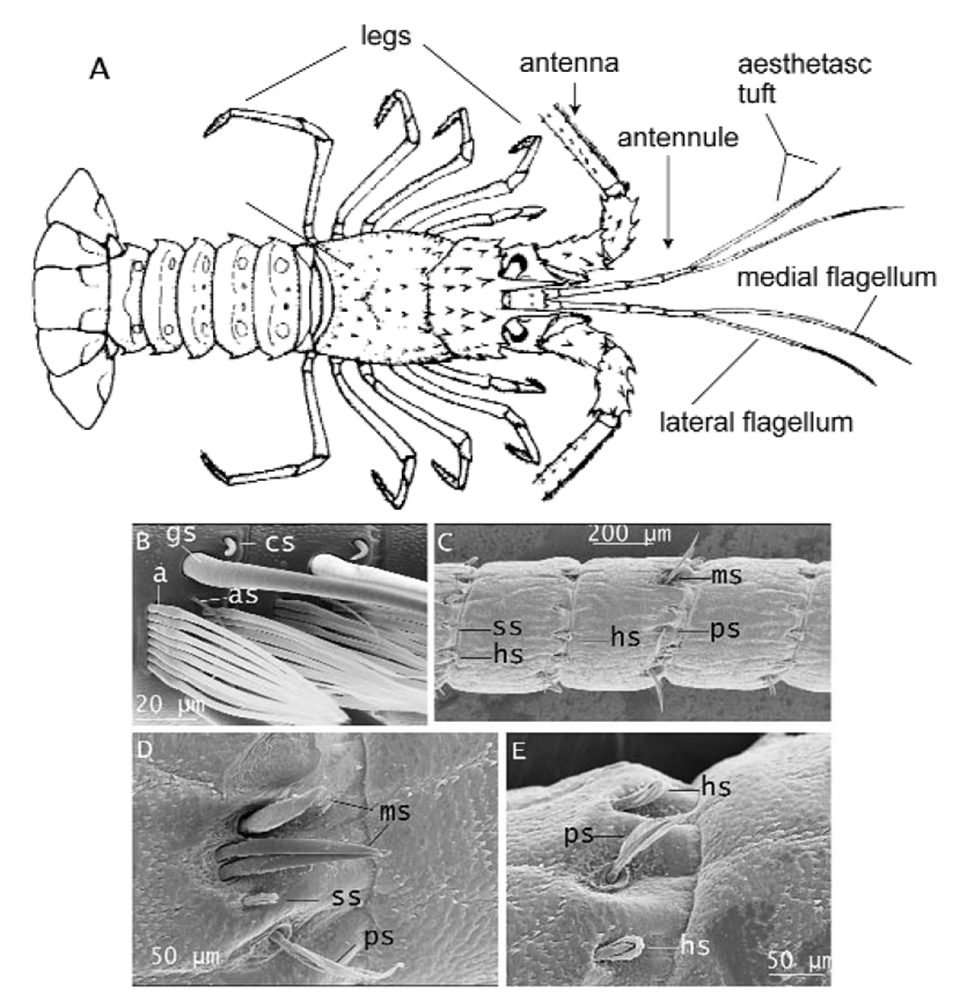
However, when we consider smells and tastes in the aquatic habitat, we have to reassess our ideas of what is a scent and what is a “tastant.” Since aquatic animals live in water, the chemicals that are important in signaling food and mates are water-soluble. Volatility of compounds has no bearing for fish and crustaceans. Thus, the chemicals that are “smelly” to us based on their chemical structure and volatility are often inert to aquatic animals.
For example, catfishermen generally are concerned with using “stink baits,” the idea being that the smellier the bait, the better the chance the catfish will detect and bite it. However, the fishermen are rating the bait on its volatility, whereas the fish will evaluate it on its water-solubility. Thus, unless the specific stink bait emanates some attractive water-soluble components, it is likely to be a poor bait.
My laboratory at Louisiana State University in Baton Rouge, Louisiana, USA has developed a water-soluble catfish bait that has no odor or taste to humans, but causes channel catfish to become alert, bite and snap, and search for food. Thus, in the aquatic habitat, both smell and taste systems detect water-soluble chemicals, and both systems can be equally sensitive to specific compounds.
Although water-soluble chemicals can theoretically be smelled and tasted by aquatic animals, each system can be more sensitive than the other to particular chemicals. This sensitivity depends on the numbers, types, and binding affinities of the receptors for the chemicals. Further, taste and smell systems can trigger different animal behaviors, depending upon which system is dominant in the detection and processing of the specific chemical.
Feeding attractants
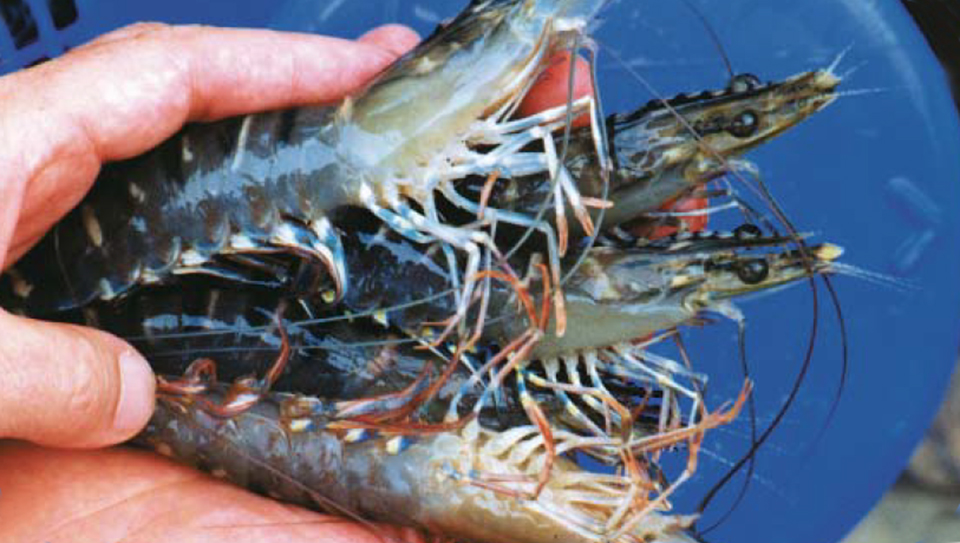
The major components of feeding stimuli reported over the years have been relatively small, water-soluble chemicals, such as amino acids, small peptides, amines, nucleotides and nucleosides and quarternary ammonium bases. Amino acids can exist in two forms, L and D, which are mirror images of each other.
In the vast majority of cases, L-amino acids are detected by olfactory and taste systems better than the D forms. It is the L forms that make up proteins. The combination of these substances released into the water column from prey alerts fish and crustaceans to the presence in their environment of living or recently deceased food organisms.
A commonly held view is that sharks are attracted to blood. Sharks don’t have “blood cell” receptors, but are attracted by the water-soluble components within the plasma. In a similar way, worms make an excellent bait, but not because fish have “worm receptors.” Worms release small, water-soluble chemicals into the water that excite taste and/or olfactory receptors in fish. This explains why is better to use a fresh worm than one submerged on a hook for some time, since much of the water-soluble components will leach out of the “old” worm.
If a fisherman could identify the specific chemicals that trigger feeding activity in his target species, then the entire worm would be unnecessary. Most likely, 95 percent or more of the mass of the worm is inert and does not act as an attractant. Therefore, of critical importance is the correct identification of attractants specific to particular species of fish or crustaceans.
Ingredients like fish solubles, which are rich in these water-soluble components, are excellent candidate attractants. Fat- or oil-based materials are generally immiscible in water, and therefore are not optimal chemicals to attract or activate feeding. Even though some aquaculturists apply fish oil as a perceived attractant, its minimal content of water-soluble compounds makes it poorly effective as a feeding activator in fish or crustaceans.
Amino acids
Of all the water-soluble chemicals identified as important for feeding in aquatic animals, amino acids have been most studied. Since amino acids leach out of all living organisms, it could be questioned as to how they serve as feeding cues. It seems fish and crustaceans would be inundated by these chemicals in the aquatic habitat, and their taste and smell systems would adapt and become insensitive to amino acids.
The answer is that bacteria and algae have potent systems for taking up free amino acids from the water column. Thus, if the taste and/or olfactory system of an aquatic animal detects free amino acids in the water, something that could serve as a food source has been in the vicinity recently.
Amino acids are detected by both taste and smell systems of fish and crustaceans, but combinations of specific amino acids may serve as a better attractant than all 20 of them mixed together. The animals’ chemical receptors were designed by nature to detect specific L-amino acids, and the specific amino acids that are most stimulatory may be different between those detected by taste and those detected by smell.
Focus on taste
In my laboratory studies of attractants, it was best to identify the specific amino acids that stimulated the taste rather than olfactory system of each species. These chemicals would also be detected by olfactory receptors, but it was the maximal activation of the taste system that led to food search and ingestive behavior.
Our LSU researchers learned that the specificity of the taste system of a fish species for particular amino acids was conserved across other species in that family of fishes. However, a different family of fishes had a different order of amino acid taste specificity. Not as much is known regarding the olfactory specificity of fishes as it pertains to feeding behavior.
Peptides
Combinations of amino acids form compounds termed peptides. Peptides can consist of as few as two amino acids linked together (a dipeptide), or hundreds of linked amino acids that form polypeptides and proteins. In all the research on sensory systems of fish and crustaceans, a general finding is that free amino acids are more stimulating than any known peptide.
Even a dipeptide made from two molecules of the same amino acid is much less stimulating than the single amino acid. Further, no peptide has been found more stimulating to taste and/or smell in fish and crustaceans than the most stimulating single amino acid component of the peptide.
Finding better bait
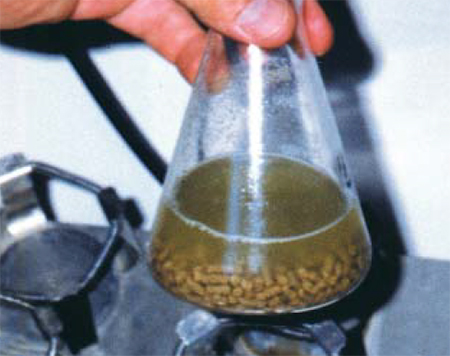
Two general methods have been used for designing effective attractants or baits. In the first, the major food item of the targeted species is determined. Then, a biochemical analysis of the prey material is performed to determine the major water-soluble components under a molecular weight of 1,000 and their respective amounts in the prey tissue. One can then purchase the individual components in the specified amounts to formulate the water-soluble equivalent of the prey item and incorporate them into feed.
The second method is to directly “ask” the aquatic organism what it wants. Using electrophysiological techniques, my laboratory directly views the activity of taste and smell neurons that transmit chemical sensory information to the brain in a living, anesthetized fish. This is somewhat analogous to a physician viewing the electrical activity of your heart in an electrocardiogram.
We view and record the response of the animal’s taste and smell systems to specific stimuli of our choosing. For example, we can effectively ask the fish, “Do you smell or taste a specific chemical?” Based on the monitored nerve and brain activity, we can determine the lowest concentration at which the fish detects the chemical, and how specific its taste and smell receptors are to the compound.
This method allows us to study which of the many water-soluble compounds given off by prey items actually are best at exciting the taste and smell receptors. In this way, by determining the “essence” of the prey item, a much smaller list of possible attractant compounds is identified.
This information is then used to design behavioral experiments that enable us to determine which of the two chemosensory systems is more responsible for a particular observed behavior. This final protocol allows us to choose the best identified compounds to serve as possible feeding attractants in fish baits and feeds.
Conclusion
As the trend toward replacement of marine animal meals by plant proteins continues, it will become more important to supplement diets with effective attractants to stimulate feeding behavior. Fish and crustaceans detect food through smell and taste of water-soluble compounds of low molecular weight.
Electrophysiological and behavioral research with certain species has identified specific combinations of chemicals that deliver a strong feeding stimulus. Improved knowledge of attractant compounds for different species will facilitate the transition from marine meals to alternate natural and synthetic sources of defined water-soluble compounds.
(Editor’s Note: This article was originally published in the April 2001 print edition of the Global Aquaculture Advocate.)
Now that you've reached the end of the article ...
… please consider supporting GSA’s mission to advance responsible seafood practices through education, advocacy and third-party assurances. The Advocate aims to document the evolution of responsible seafood practices and share the expansive knowledge of our vast network of contributors.
By becoming a Global Seafood Alliance member, you’re ensuring that all of the pre-competitive work we do through member benefits, resources and events can continue. Individual membership costs just $50 a year.
Not a GSA member? Join us.
Author
Tagged With
Related Posts
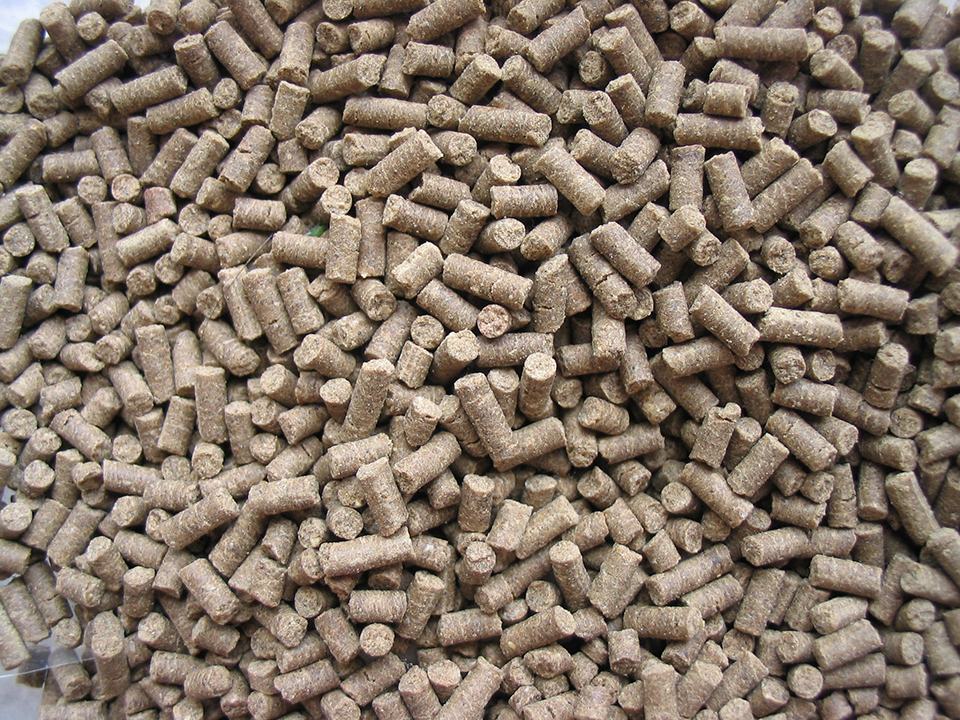
Aquafeeds
Chemoattraction in aquatic feed management
The value of chemical stimulants to shrimp farming will come via reproducible methods to evaluate the efficacy of chemoattractants and feeding stimulants.
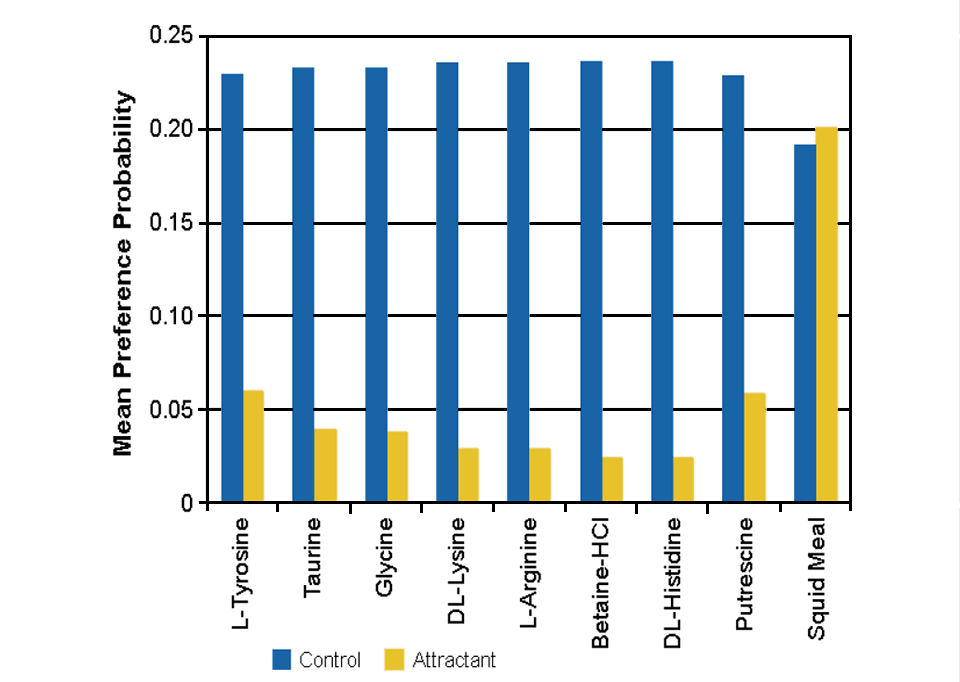
Health & Welfare
Chemoattraction of low-molecular-weight compounds in shrimp feeds
The methodology used in a Texas Agricultural Experiment Station study provided a useful tool for evaluating the attractiveness of individual ingredients in prepared shrimp feeds.

Aquafeeds
Feed management for RAS, part 2
The higher cost of feeds for RAS can be offset by better management, since it is easier to feed frequently and monitor uneaten or wasted feed.
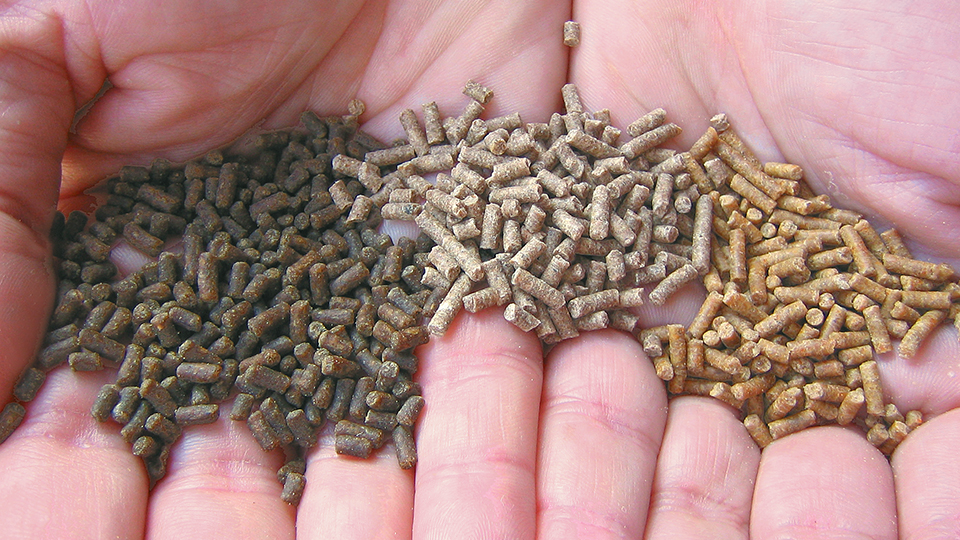
Aquafeeds
Extruded shrimp feeds reemerge
The process for making extruded shrimp feeds has flexibility to produce diets with a wide range of fat levels, densities, shapes and sizes.



